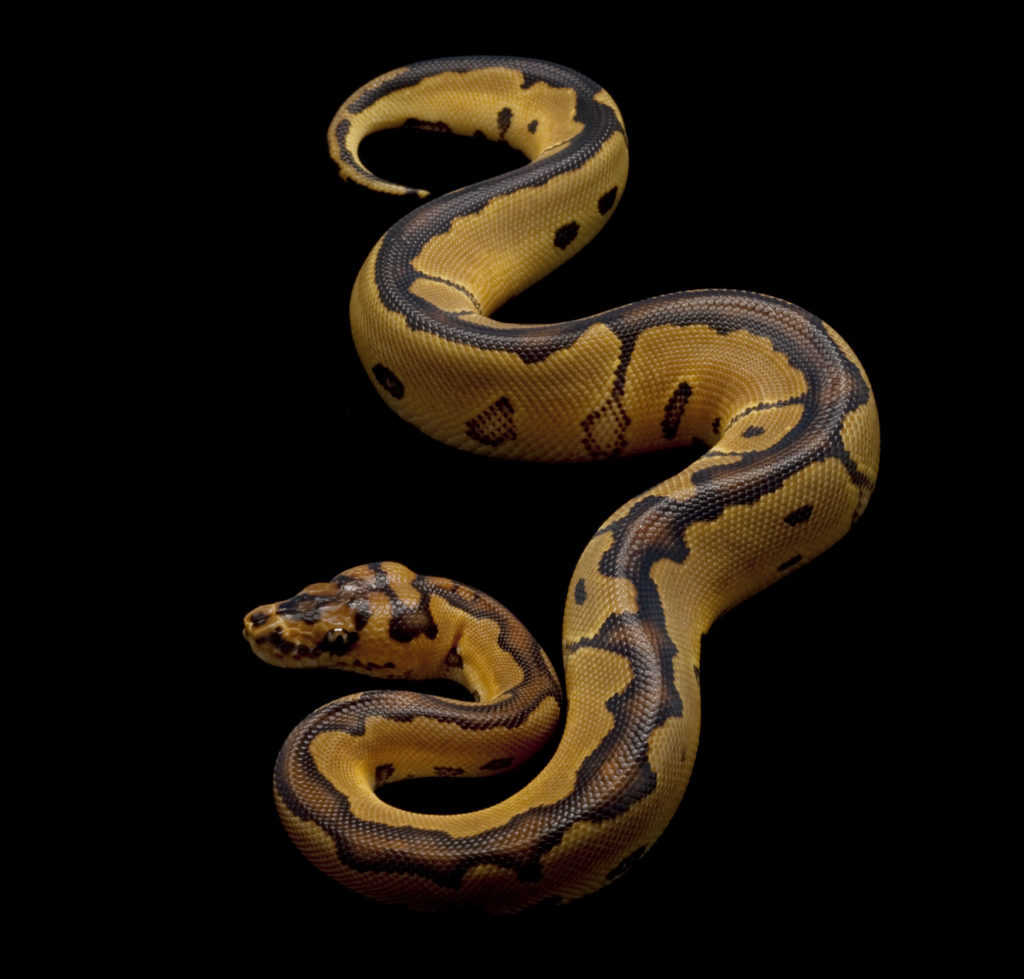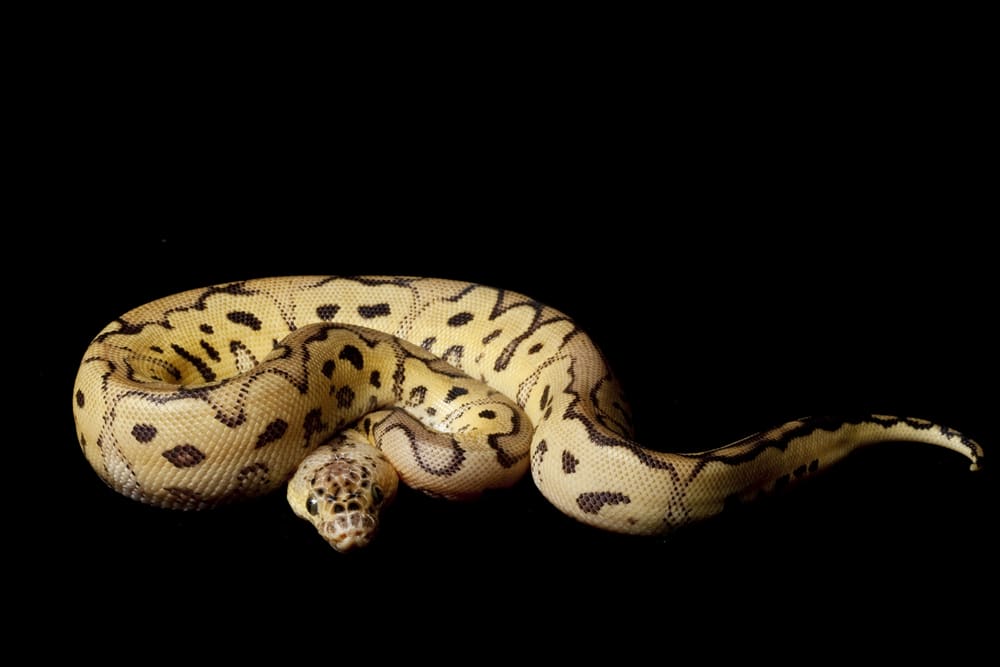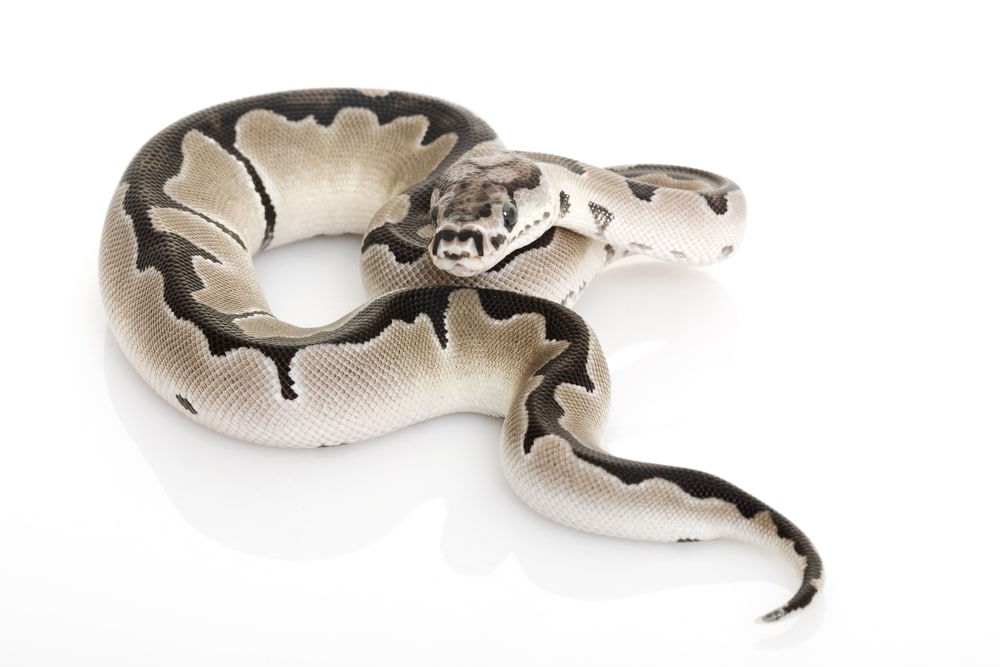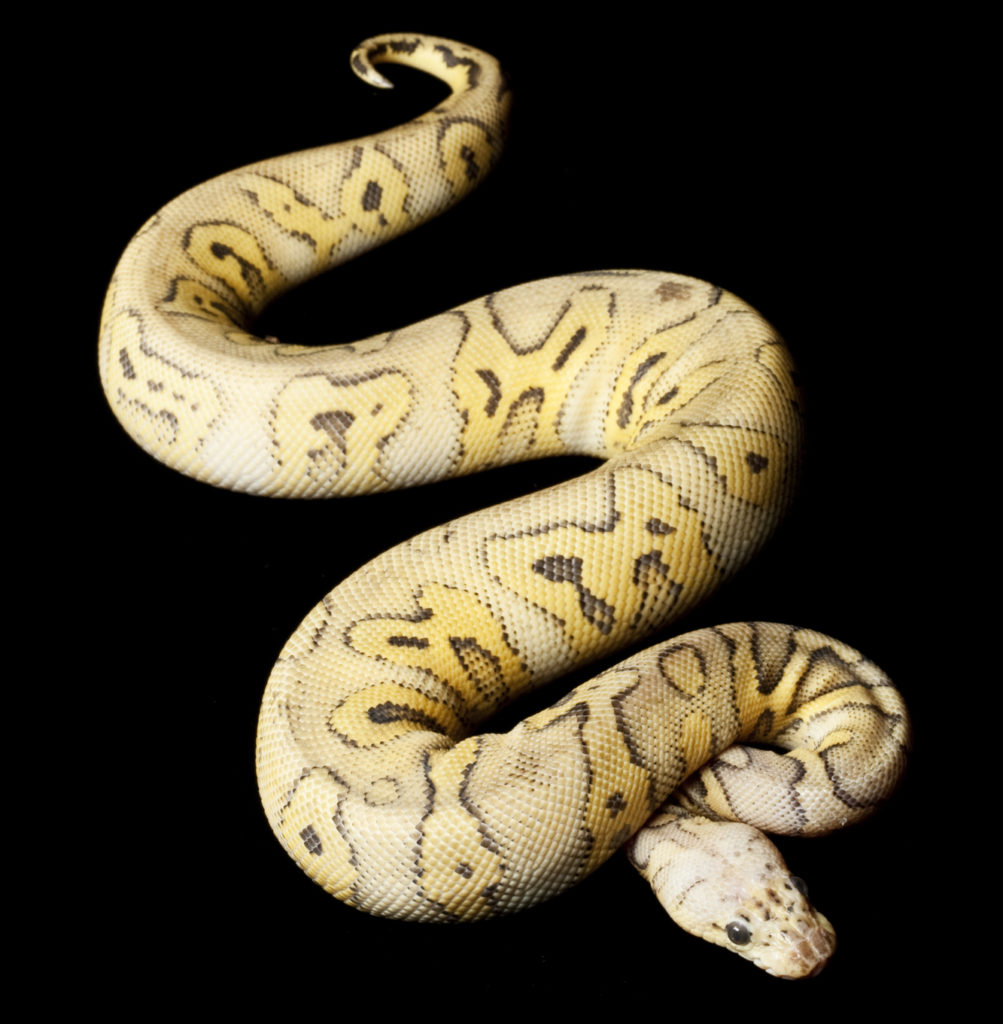In 1996 Dave and Tracy Barker of VPI acquired an interesting male ball python from Africa.
The baby ball had an unusually mottled head pattern, an odd body pattern and a pale yellowish-gold background with none of the typical ball python stippling. One spot under his eye reminded them of a harlequin’s tear, and so they called him a Clown ball.

In 1997 VPI received 1.2 African hatchlings which also showed these color and pattern anomalies. In 1998 the Barkers bred the first baby to normal females and produced clutches of normal-looking balls. This proved that the Clown pattern was not co-dominant like the Pastels. But was Clown a heritable trait, or an aberration which could not be passed down to the next generation?
A 1999 breeding of the 1997 Clowns produced Clown offspring. In 2000 the 1996 Clown was bred with the 1997 Clowns and produced still more Clowns. Another snake breeder, Brian Barczyk of BHB Reptiles, owned a wild-caught female who appeared to have the Clown mutation. When bred to a VPI Clown male in 2001, Barczyk’s female produced Clown offspring. The Barkers had a proven recessive morph on their hands – and a beautiful one!
Serious breeders rushed to VPI’s door to purchase their own Clowns and het Clowns. Big names like NERD and The Snake Keeper (TSK) purchased het Clowns and within a generation or two had their own stable of Clown breeders. Their investment paid off, as Clown balls became one of the most sought-after morphs on the then-hot ball python morph market.
The price of Clowns has dropped considerably since their introduction. A Clown that would have cost you $6,000 or more in 2005 can today be had for under $300. But Clown balls are still strikingly beautiful snakes which only get more attractive as they mature. If you want to add a ball python morph to your collection, you can’t go wrong with a Clown.
This article will tell you more about the Clown ball python morph. It will explain the genetics of piebaldism and help you understand why your Clown ball has such beautiful coloration and patterns. It will also talk about some of the designer Clown morphs which are available. Armed with that information you can decide how Clowns fit into your collection as pets or breeders.
Quick Navigation
Clown Ball Python Morph Appearance
Clown ball pythons have little or no lateral dark pattern. Instead of saddles they have splotchy darker patches. Their sides have a golden hue, and they have a pronounced blotchy, wide dorsal stripe. There is no mistaking a Clown for a normal ball python – or for any other morph!

Most ball pythons become darker with age. As Clowns mature, their color grows increasingly pale. By adulthood their dark pattern becomes a pale yellowish brown against a dark tan background. The older they get, the more attractive Clowns become!
Patterns vary between different Clowns. Some have numerous blotches running from their dorsal stripe down their flanks. Others have largely clean flanks with only a few slender markings that look like dripping paint. All have a large dorsal stripe with irregular edges.
Other than their unusual appearance, Clowns are generally no more prone to problems than normal ball pythons. A healthy baby Clown purchased from a reputable ball python breeder and raised in a proper environment should have no problems thriving or producing healthy offspring.

Genetics
In vertebrates the melanocortin receptor (Mc1R) produces a dark brown to black pigment called eumelanin. Proteins produced by the agouti signaling protein gene (ASIP) act as an antagonist to the Mc1R receptor.
If the Agouti protein binds to the Mc1R gene, it blocks the alpha-Melanocyte Stimulating Hormone (α-MSH). Instead of producing eumelanin, the Mc1R produces a yellow-red pigment called pheomelanin.
The Clown gene strongly reduces the production of melanin. Like Albinos, a Clown’s shed shows no trace of the dark pattern you find on a normal ball python’s shed. The dusting of black scales you find in the brown areas of a normal ball’s skin do not appear on a Clown.
As a ball python embryo develops in the egg, pigment cells begin migrating toward the skin. Pigment cells activated by α-MSH will produce eumalin, while those activated by the Agouti protein will produce pheomelanin.
The distribution of α-MSH and Agouti produce the ball’s pattern. Areas with more eumelanin will be dark brown or black, while those with more pheomelanin will be lighter. The Clown gene produces a darker dorsal stripe and lighter sides.
While the general pattern is predictable, the specifics of the distribution are not. We know that a Clown’s head will have mottling. We cannot tell whether or not they will have teardrop markings like the Barkers’ first clown, nor tell whether they will have more or fewer patchy markings along their sides.
Pattern of Inheritance
The Clown gene is recessive. Both parents must carry the gene and the zygote must receive a copy from each. The offspring of a Clown ball python and a normal ball will all look like normal ball pythons. But each will carry one copy of the Clown mutation.
If one of these “het Clown” ball pythons mates with a Clown, half the clutch will be Clown and the other half het Clown. But when two het Clown balls mate, things become more complicated. That clutch will consist of:
- 25% Clown
- 50% Het Clown
- 25% Normal
If a het Clown mates with a normal ball, half the clutch will be het Clown and half normal balls. Breeders describe these clutches by the chance each normal-looking ball has of being het Clown.
- Clown + normal: 100% het Clown
- 100% het Clown + 100% het Clown: 66% het Clown
- 100% het Clown + Clown: 50% het Clown
Some breeders claim het Clowns have brighter coloration than normal balls. Others look for white tail tips or wider white lines around the dark pattern. But these are not reliable indicators. A normal-looking ball may later prove het after it produces Clowns, and white tail tips appear on some normal balls. When purchasing het Clowns, a reliable breeder will be your best guarantee.

Clown Ball Python Issues
Clown ball pythons are no more prone to genetic problems than normal ball pythons. Because the Clown morph is frequently combined with other morphs to create designer balls, you should check those morphs to see if they can lead to neurological, skeletal or fertility problems.
Popular Clown Ball Python Combinations
While the Clown morph is very attractive on its own, it really shines when combined with other morphs. Today it can be easier to find a “designer Clown” with two or more morphs than a regular Clown. Among the most popular combinations are:
Clown x Albino:The Clown’s blotchy pattern and wide dorsal stripe is especially striking when combined with Albino coloration. The interplay of white and yellow looks like a lava lamp or an abstract painting.
Clown x Axanthic: An Axanthic Clown gives you the Clown pattern in shades of gray. Axanthic Clowns will not darken as much as regular Axanthics. Before breeding your Axanthic Clown, make sure you are working with the same breeder line.
Clown x Banana: A Banana Clown replaces the Clown’s golden-tan coloration with a brilliant yellow. The stripe and pattern are reproduced in pale lilac. And if you breed a Banana Clown to a Clown, half the offspring will be Banana Clowns.
Clown x Enchi: Like Clowns, Enchis improve with age. Enchi Clowns have brighter colors, fewer flank patterns and a more sharply defined dorsal stripe, albeit one which may be broken in one or more places.
Clown x Fire: The Fire gene produces a lighter ball with a golden hue. Fire Clowns are more golden. In a Fire Clown x Pastel Clown breeding, 25% of the offspring will be stunning bright yellow Fire Pastel Clowns, or Firefly Clowns.
Clown x Mojave: A Mojave Clown’s flank patterns are lighter, with areas of near-white that look like they were airbrushed. Breeding two Mojave Clowns together will give you 25% Super Mojave Clowns, a blue-eyed leucistic white snake that will produce 100% Mojave Clowns if bred to a Clown.
Clown x Pastel: The Pastel morph also reduces eumelanin production. The Clown Pastel is one of the most impressive Pastel combinations, with brighter tans and paler patterns. Breed two Clown Pastels together and 25% of your clutch will be spectacular Super Pastel Clowns.
Clown x Piebald: Harlequins traditionally wore “Pied” clothing with patches of white. Combine the Clown’s jolly pattern with Piebald patches and you have a harlequin you won’t soon forget!
Clowns have been used to create some amazing triple and quadruple combinations, including:
- Banana Clown Mojave
- Black Pastel Clown Ghost
- Clown Leopard Pastel Piebald
- Clown Pastel Super Phantom
- Clown Lesser Super Pastel (Killer King Clown)
- Lesser Enchi Clown
- Clown Coral Glow Lesser Spotnose

Caring For a Clown Ball Python
Clown ball pythons are no more difficult to raise than a normal ball python. Give them adequate space, a comfortable hiding place, fresh water and a temperature gradient between 75° and 95°. Misting your Piebald’s container with a light spray of water every couple of days will help ensure clean and complete sheds.
It is best to feed Clown balls, and ball pythons in general, with frozen/thawed food rather than live prey. A cornered rat can injure or even kill a snake. If you have a fussy ball which turns up its snout at frozen food, you should stun or kill the prey before feeding. You can also try scenting thawed rats with chicken broth before feeding.
Many fussy ball pythons are actually refusing food because of stress. If your Clown is refusing to eat, give them some quiet time. A towel over their cage can provide privacy and smaller prey items may prove more appealing than larger ones. And if your Clown’s stress is making you stressed, remember that snakes often go months without food in the wild.
If you can see your fasting snake’s spine or if it loses dramatic amounts of weight, you should take it to a veterinarian. Otherwise, there is no need to be concerned. Your Clown will eat when it is ready to eat.
Conclusion
Clown ball pythons are beautiful, easy to keep and relatively inexpensive. Take your time to find a reputable dealer. The extra money you spend buying a snake from one of the best breeders may save you heartache, time and veterinary bills in the future.
There are many forums for ball python lovers. The Kingsnake Ball Python Forum, BP Forums and Fauna Classifieds Ball Pythons Forum have professional breeders and experienced amateur owners who will be happy to answer your questions.
Do you have a Clown ball python? What advice would you give somebody thinking about adding a Clown to their collection? Do you have any questions we haven’t answered? Share your stories, thoughts and photos in the comments below!